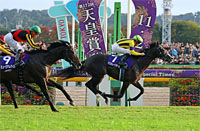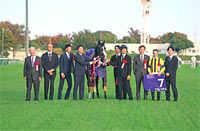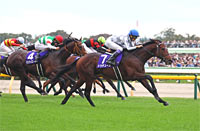2017 News
Tenno Sho (Autumn) (G1) - PreviewOn Sunday, Oct. 29, Tokyo Racecourse hosts the top-level excitement with the ultra-prestigious Tenno Sho (Autumn). The lineup is weighty indeed, with eight top-level champions expected to fill out the final gate of 18. And, above the saddles, five non-Japanese jockeys are expected to turn the heat up for some very keen competition. The brightest spotlight will be on 2016 JRA Awards dual winner Kitasan Black, back to make good on his Takarazuka Kinen loss in the rundown to his scheduled year-end retirement. But, 20 others have been nominated for the race and they’re no pushovers. Seventeen of them have won graded races. The Tenno Sho is run twice a year, with a spring version over 3,200 meters at Kyoto Racecourse, and the autumn version over 2,000 meters at Tokyo. The race was officially inaugurated in 1937, but has its roots as far back as 1905. This year is the 156th running of the versions combined. The autumn version is open to 3-year-olds and up, with 4-year-old colts and older horses carrying 58kg (3-year-olds carry 56kg), fillies and mares allocated 2kg less. Important preps for the Tenno Sho (Autumn) are three Grade 2 races – the All Comers at Nakayama Racecourse over 2,200 meters, the Mainichi Okan over 1,800 meters at Tokyo, and the Kyoto Daishoten over 2,400 meters at Kyoto. The Tenno Sho (Autumn) is one of only two graded races run over 2,000 meters on turf at Tokyo. The race starts in the pocket just past the grandstand, and there are only 130 meters until the first turn. Pace tends to be slow and those with the fastest late speed usually win the race. In earlier years, upsets were the norm for the fall edition, but the last decade has seen the favorite win five times, come runner-up twice, and third place twice. Tosen Jordan holds the race record with a time of 1 minute, 56.1 seconds set in 2011. The Tenno Sho (Autumn) is the 11th race on the Sunday card of 12 at Tokyo. Post time is 15:40 local time. The winner will take home 150 million yen. Here is a look at the expected top choices: Kitasan Black: If all goes well, three races remain for Kitasan Black – the Tenno Sho (Autumn), the Japan Cup and the Arima Kinen – a trio known as the autumn triple crown. A 5-year-old by Black Tide, Kitasan Black captured both Horse of the Year and Best Older Colt or Horse for 2016 with two top-level wins and never figuring out of the top three in any of his six starts that year. He also amassed close to 712 million yen that year in earnings for owner Saburo Kitajima. This spring, Kitasan Black won two more Grade 1s, the Osaka Hai in early April and the grueling Tenno Sho (Spring) at the end of that month. Just two months later, he was dropped back a full 1,000 meters for the Takarazuka Kinen. The favorite for three races straight, he ran at his heaviest weight yet, 6kg up from the Tenno Sho (Spring), and failed to fire in the stretch, finishing in ninth place and some 8 lengths behind the winner. Though there had been talk of an Arc bid, trainer Hisashi Shimizu opted to give his prize charge much-needed time off and Sunday will be his first race since the Takarazuka Kinen. “I think he was more tired than he appeared to be going into the Takarazuka Kinen,” Shimizu said. “He’s a smart horse and I have the feeling that he quit running on his own before he could injure himself. This time I wanted to get him ready slowly and brought him back to the training center early.” Kitasan Black, only the fourth horse ever to win the Tenno Sho (Spring) back-to-back, is aiming to become the second horse since T.M. Opera O in 2001 to win three runnings of the Tenno Sho, and only the fifth horse to win both the spring and autumn versions in the same year. It will be Kitasan Black’s first time to take on the fall version, but the distance is not considered to be a problem. He has won two starts out of four over 2,000 meters, one of them at the Grade 1 level. Yutaka Take, who has ridden Kitasan Black’s last nine starts, is up Sunday and looking for his first win of the Tenno Sho (Autumn) in nine years. Take has won 13 Tenno Sho titles – six in the fall, seven in the spring. Satono Crown: This 5-year-old son of Marju hails from the Miho-based stable of Noriyuki Hori, who fielded last year’s champion Maurice and also fields Neorealism in this race. A Grade 1 winner overseas as well, Satono Crown lost the Osaka Hai but came back to win the Takarazuka Kinen. His past two Tenno Sho (Autumn) results were double digits, but his luck may change with Italian rider Mirco Demuro in the saddle. Demuro has won with Satono Crown on three of their four previous pairings. Softer ground would also be a plus for Satono Crown. Demuro looks to make it two Grade 1 wins in a row following his win on Kiseki last Sunday in Kyoto’s Kikuka Sho (Japanese St. Leger) and Demuro’s first win of the fall Tenno Sho since he pulled it off on Eishin Flash in 2012 with the Emperor and Empress of Japan watching from the grandstand. His younger brother, Cristian Demuro, is also expected to be in the lineup Sunday, riding Sciacchetra, who takes his name from a sweet Italian wine. The brothers turned in a one-two finish in the 2013 Oka Sho (Japanese 1000 Guineas). Real Steel: Last out, this Deep Impact-sired 5-year-old captured the Grade 2 Mainichi Okan, his first win in his five starts since claiming his first Grade 1 victory, the Dubai Turf. Last year, Real Steel finished second in the Tenno Sho (Autumn), 1 1/2 lengths behind Maurice. Although he pales in comparisons to Kitasan Black, Real Steel did beat the latter in both the Satsuki Sho (Japanese 2000 Guineas) and the Tokyo Yushun (Japanese Derby). Real Steel is set to be piloted by French rider Vincent Cheminaud, who first rode in Japan last December, which included two starts with Al Ain, who went on to win the Satsuki Sho this year. Satono Aladdin: Trainer Yasutoshi Ikee weighs in with two nominations. The 6-year-old Satono Aladdin by Deep Impact was this year’s Yasuda Kinen champion and last out missed the Mainichi Okan winner’s circle by a neck. “He wasn’t exactly keen,” Ikee said. “But he did have the bit in his teeth over the first half. The jockey had a tough ride, but he did get that close in the end. I got him ready with room for improvement for the next race and he came out of the Mainichi Okan well.” Although ridden mostly in the mile range recently, Satono Aladdin has had two wins and a third at 2,000 meters, most of them early in his career. His last start at the distance was the Hong Kong Cup in December 2015, when he finished 11th out of 13. “I’d say 1,800 meters is about his limit, so the distance really will be key,” Ikee said. Satono Aladdin will be ridden by Yuga Kawada, who has ridden the horse’s last eight starts, which include three wins. Staphanos: Staphanos started his fall campaign with the Grade 2 All Comers over 2,200 meters and was beaten by half a length by the mare Rouge Buck. Two years ago, he ran second in the Tenno Sho (Autumn) after a seventh in the Mainichi Okan and last year turned in a fifth and a third with the same rotation. Staphanos has yet to win a Grade 1 race in his nine bids so far, but he is experienced at 2,000 meters and is a consistent runner. A good bet to make the top three, Staphanos has notched four seconds and two thirds at the distance, including a second in this year’s Grade 1 Osaka Hai. Keita Tosaki, in midst of a battle for the JRA’s leading jockey with Christophe Lemaire, is scheduled for the ride. Soul Stirring: In the Mainichi Okan, two-time Grade 1 winner and overwhelming race favorite Soul Stirring was a bit slow out of Gate No. 1 and was sent to the lead for the first time in her career. The new strategy, as well as it being her first time running against older horses, may have rattled her concentration. Also, with her late speed, the 3-year-old daughter of Frankel may have been looking for a bit more ground. It should also be noted that in the past decade, of the eight horses who won the Mainichi Okan and went on to the Tenno Sho (Autumn), only one of those has won. Soul Stirring, the only female nominated for the Tenno Sho (Autumn), will have a weight advantage, carrying the lightest weight of the field at 54kg. She is paired with Lemaire. If she can win, she would become the first 3-year-old filly in the history of the race to do so.
Comments sources: Keiba Book, Netkeiba
|
|


























